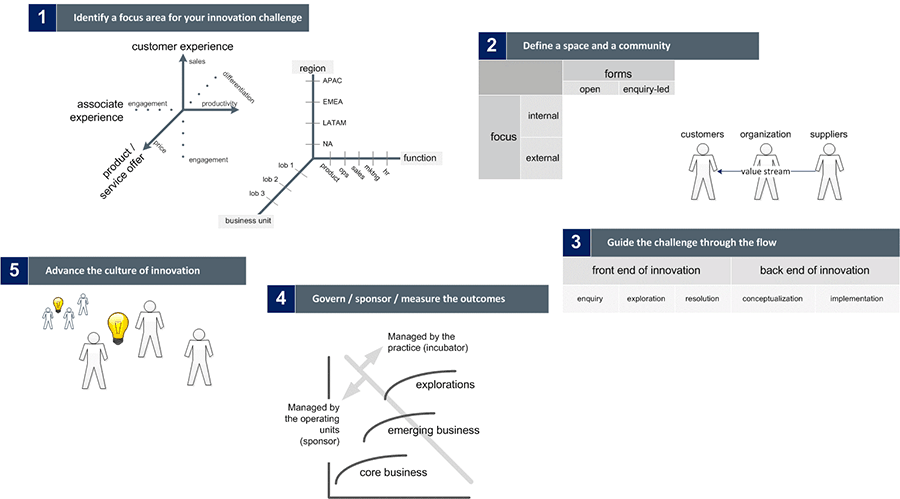By: Doug Collins
Our columnist Doug Collins began the Dirty Maple Flooring Company tale last fall. Twenty episodes later, the story in which Dirty Maple embraces collaborative innovation has come to an end.
In this article Doug reflects on his own learning from having told the story. How has his own understanding of the practice of collaborative innovation evolved?
Readers may navigate the Dirty Maple series here. Doug releases the e-book version of the Dirty Maple story on Apple iTunes here this September.
How could I, warm, safe, and dry on my consultative perch, encourage others to take the leap without going over the cliff, too?
Reflection
When we can be sure of nothing then we must be sure of the process by which we resolve ambiguity.
What’s Good for the Innovation Management Goose
In my work I encourage clients to “realize the potential for leadership through their practice of collaborative innovation”—that is, have the vision and find the courage to help their colleagues pursue their ideas to resolution. Be creative.
As I exhort, the thoughts of “practice what you preach” and “walk the talk” occur to me. Be mindful.
How could I, warm, safe, and dry on my consultative perch, encourage others to take the leap without going over the cliff, too?
This “what’s good for the goose” spirit started me on my own journey of creativity: changing my prescriptive column on Innovation Management (“the three things you must do”) to a narrative on how a fictional company—the Dirty Maple Flooring Company—made its way in the Digital Age by embracing the practice of collaborative innovation.
The story comes from my own experiences with clients as they have gone down the same path. The collaborative innovation blueprint serves as the point of reference for the story, as the protagonist Charlie Bangbang executes and overcomes challenges in applying it at the company.
Revelations in Crowdsourcing
They say you write your first draft for your own understanding. With subsequent drafts, you have your audience increasingly in mind.
This was my experience with Dirty Maple.
Dirty Maple, over time, forced me to articulate more fully the blueprint that I have used with clients to cover the realistic scenario depicted in the story (figure 1).
Figure 1: the evolution of the collaborative innovation blueprint
In the past, the third phase, “flow,” implied that the practitioners would find a way to shepherd, sponsor, or otherwise pursue ideas from the front to the back end of innovation, from resolution to conceptualization. I had written an article before Dirty Maple, exploring how one might do so, in practice.
In reality, many of my clients wrestle with this transition. The segue raises a host of issues that threaten the integrity of their practice: issues of governance, sponsorship, roles, measurement, and outcomes.
This weighty matter deserved its own episode in Dirty Maple and its own callout as “governance” (#4) on the blueprint, itself.
Writing the Dirty Maple story also caused me to reflect anew on why, exactly, people participate in collaborative innovation. A recent article in PC World, for example, calls out the reasons why people choose not to participate in the virtual form of collaborative innovation through an enterprise social network (ESN). My experience tells me that technology, rather than being a determining factor (i.e., the better the technology, the better the engagement), serves instead as a litmus test for the organizational culture.
Organizations that value problem solving, either because they differentiate themselves on their customer experience (e.g., provide latitude for people to solve problems on behalf of customers) or on their offer (e.g., fund the “r” in research and development) by nature tend to enjoy better results with ESNs. The ground was fertile, to start.
The existing culture, as with one’s genetic makeup, determines a sizable chunk of one’s future. The Digital Age—with the challenges and capabilities it brings, serves to illuminate in starker relief existing strengths and weaknesses.
To this end, I devoted several episodes to the cultural challenges any practitioner would face, based on common scenarios I have encountered in my own work. These challenges include (a) the inability to determine or reach a shared understanding of what is the critical question, (b) the fear that being seen as having time to participate in collaborative innovation is a sign of not having enough “real work” to do and, (c) the hesitation an organization can feel—individually and collectively—when it mulls connecting the practice to its rewards and recognitions system.
In Dirty Maple I presented some challenges in a positive light: Charlie and company find a way forward. In other cases, I left the matter unresolved. This mixed bag of outcomes reflects reality.
Looking Ahead: an Apple iBook this Fall
A number of clients and colleagues have expressed to me the desire to have something tangible—a guide—that they in turn can give their fellow practitioners to help them navigate forward.
What does success look like? How might we get to our own version of it?
To this end, I take my final leg of the Dirty Maple journey: turning the 20 episodes as they appear in Innovation Management into a tighter, visually rich e-book on Apple iTunes. This deliverable becomes the third addition to the Innovation Architecture series.
To close, what about Charlie, Kaylee Jo, Harry, and the people at the Dirty Maple Flooring Company?
Well, that’s the thing—the exciting, rewarding, frustrating, and, at times, scary thing: it’s up to them.
What they have the courage to envision; what they have the discipline and ability to execute.
We see them in all of us.
By : Doug Collins
About the author
 Doug Collins serves as an innovation architect. He helps organizations such as The Estee Lauder Companies, Jarden Corporation, Johnson & Johnson, The Procter & Gamble Company, and Ryder System navigate the fuzzy front end of innovation. Doug develops approaches, creates forums, and structures engagements whereby people can convene to explore the critical questions facing the enterprise. He helps people assign economic value to the ideas and to the collaboration that result.
Doug Collins serves as an innovation architect. He helps organizations such as The Estee Lauder Companies, Jarden Corporation, Johnson & Johnson, The Procter & Gamble Company, and Ryder System navigate the fuzzy front end of innovation. Doug develops approaches, creates forums, and structures engagements whereby people can convene to explore the critical questions facing the enterprise. He helps people assign economic value to the ideas and to the collaboration that result.
As an author, Doug explores ways in which people can apply the practice of collaborative innovation in his series Innovation Architecture: A New Blueprint for Engaging People through Collaborative Innovation. His bi-weekly column appears in the publication Innovation Management. Doug serves on the board of advisors for Frost & Sullivan’s Global community of Growth, Innovation and Leadership (GIL). Today, Doug works as senior practice leader at social innovation company Mindjet, where he consults with a range of clients. He focuses on helping them realize their potential for leadership by applying the practice of collaborative innovation.
Photo : Railway track black and white retrospective style by Shutterstock.com


